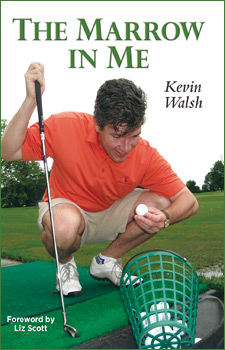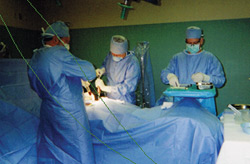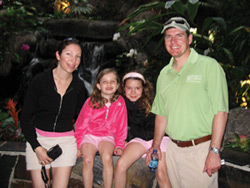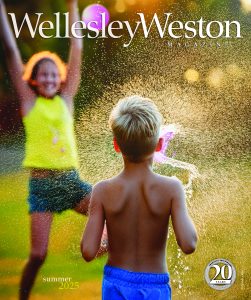The Marrow in Me by Kevin Walsh
 “The best assignments come out of the blue,” says Kevin Walsh, sports anchor and author of The Marrow in Me (Sports Challenge Network, 2009), his account of the bone marrow donation he made to an unidentified recipient and the people he met along the way. A Wellesley resident since 2009, Walsh appears regularly on Comcast Sportsnet New England and New England Cable News.
“The best assignments come out of the blue,” says Kevin Walsh, sports anchor and author of The Marrow in Me (Sports Challenge Network, 2009), his account of the bone marrow donation he made to an unidentified recipient and the people he met along the way. A Wellesley resident since 2009, Walsh appears regularly on Comcast Sportsnet New England and New England Cable News.
Examples of serendipity come up when you talk with Walsh. As he reflects on his life—meeting his wife Jean, getting a start in broadcasting, or being blessed with two daughters—Walsh says his best opportunities come when he gets out of the way and lets life unfold. One of the greatest of these events occurred in Honolulu, Hawaii where Walsh was a young television news anchor. At WGMB-TV in 1996, Walsh was asked to do a story on a man who had found a golf ball imprinted with a surprising message.
Chris Pablo, fitness fanatic and family man, had gone to the driving range to hit a bucket of balls and let go of some stress. Midway through, he noticed a ball whose dimpling and coloration were different, obviously older, and probably inferior to the rest. Rather than discard the ball, Pablo took a closer look and discovered the imprint, “Beat leukemia.” Pablo pocketed that ball. He had learned three weeks earlier that he had Chronic Myelogenous Leukemia (CML), and he took the ball as a sign of good fortune.
Pablo’s best hope for living long enough to see his sons, ages seven and nine, reach adulthood was a bone marrow transplant. He didn’t have a match in his family or in the international bone marrow registry, so he needed Walsh’s on-air reporting to bring as many people as possible to bone marrow registration drives.

Chris Pablo (right) holding the original “Beat Leukemia” golf ball. His son Nate Pablo (left) attends Maine Maritime Academy.
Walsh, a lifelong golfer, was thrilled with the assignment. This was only the beginning. The Marrow in Me tells the bigger story that was revealed over time, as Walsh encountered a toddler with lymphoma who inspired 30,000 people to register their bone marrow, a donor who was a Good Samaritan and as a result a double amputee, and an administrator at the Hawaii Bone Marrow Registry who had been a rare cross-racial donor match. We learn that Walsh, who had registered his bone marrow in Hawaii, was called four years later in Fresno, California to donate for a 16-year-old boy.
Most registrants never get the chance to donate. Knowing that the odds are one in 200 of turning up as a potential match and going to transplant, Walsh was thrilled to receive the call in the summer of 2000. Walsh doesn’t shy away from the physical aspects of his donation experience or of the marathon he ran six months later with the Leukemia and Lymphoma Society’s “Team in Training” (TNT) as a tribute to his recipient and the others he met.
Since the book’s publication, Walsh has spoken to many community and business audiences. He is a passionate advocate for bone marrow donation. At the Rotary International District Conference in Boxborough, Massachusetts in May, Walsh autographed books and encouraged everyone to stop at the next table to complete registration forms and swab their inner cheek for a tissue sample.

The harvest of Kevin Walsh’s bone marrow, July, 2000 in Sacramento, California.
Walsh lives with his wife Jean Walsh and daughters Samantha, age eight, and Amanda, age six, not far from his grandfather’s boyhood home and church. He was thrilled to discover his roots in town after moving to Wellesley, another example of serendipity. “Ours is a household of princesses,” he says proudly. Even the dog is a girl.”
In contrast, Walsh grew up in a sports-centered, all-boy household. “I had a full-contact childhood,” he says. “Occasionally we broke windows and made holes in the walls.” However, rather than treat his daughters as surrogate sons or lady jocks, Walsh delights in what he has been given. The sports anchor who would love to be a pro golfer is happy making jewelry with his daughters. “Little girls really know how to live,” he says.
Bringing things full circle, Walsh returned to Hawaii in December 2000, just six months after donating his marrow, to run the Honolulu Marathon. A regular at the gym but definitely not a runner, Walsh had been invited to join Team in Training in his hometown of Fresno, California, to lend his star power to the fundraising campaign. Walsh trained with TNT for the 26.2-mile run for three and a half months, meeting his teammates and trainer several days a week at 5:30 am.
Like the surgical procedure for donation, training and completing the marathon were physical challenges he happily endured. It was also very meaningful for him and Jean to return to Honolulu, where this miraculous journey had begun. “Take what you are given and run with it,” could be Walsh’s mantra, or, “have faith that you are in the right place at the right time even when things don’t seem to be going well” could be another.

The Walsh family at Disney World in April, 2010. Wife Jean, daughters Amanda and Samantha, and Kevin.
The day before the race, in Kapiolani Park in Honolulu, Walsh had an emotional reunion with Pablo, then thriving following his bone marrow transplant. Pablo presented him with a box of Precept golf balls stamped with the words “beat leukemia” and a request to lose them where he hoped others would encounter them and find hope and new life. “A golf ball is never lost,” Walsh says. In the final chapter, Walsh describes the locations around the country where these balls are waiting to be found.
“When you get the call, there’s no ‘NO,’” says Walsh. Somewhere in the world there is a donor to match every person, he believes, and these matches prove that sometimes the best part of us is hidden deep inside. How wonderful to discover that we all contain cells that can give life to another person, whoever and wherever he or she might be.
You can learn more about how to register as a potential bone marrow donor by visiting the National Marrow Donor Program Web site at www.bethematch.org. ![]()
© 2010 Elm Bank Media | Beth Furman, Publisher | Beth@ElmBankMedia.com


recent comments